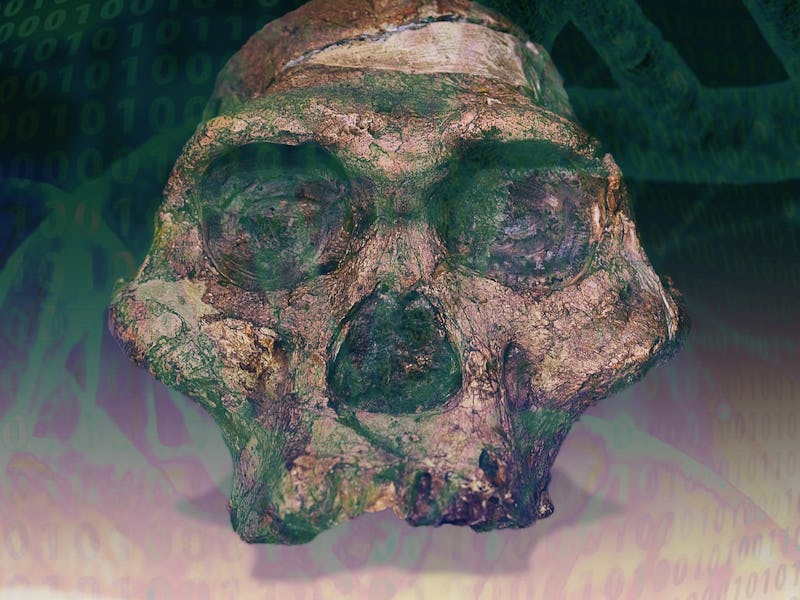Ancient "ghost" DNA identified in living humans
Scientists don't know what type of human this was.

Ancient human fossils are often found in Africa, but ancient human DNA is scarce.
Intense heat and humidity destroy DNA, so ancient fossil DNA is rarely found on the continent humans came from. But in a new study, researchers reveal that the genomes of living West Africans may hold clues to a mysterious, ancient hominin — a "ghost" human species that currently can't be identified.
The data add another layer of complexity to the story of human history. They also add to our growing understanding of which ancient human species' genetic signatures remain in present-day African genes — just as modern-day Europeans carry Neanderthal DNA.
“We hope that this will lead to exploration of complex models of human history that account for these interactions,” study co-author Sriram Sankararaman tells Inverse.
“The fact that segments of archaic ancestry are present in African genomes leads us to wonder how archaic DNA is impacting human biology," he says.
The results were published Wednesday in the journal Science Advances.
The hunt for strange genes
Sankaraman and Arun Durvasula, both affiliated with the University of California, Los Angeles, examined genomes of 405 West Africans currently living in Nigeria, Gambia, and Sierra Leone. The DNA was collected as part of the 1,000 Genomes project.
They compared these genomes to the genomes of Neanderthals and Denisovans using a novel method with an “improved sensitivity” to finding archaic genomes without a reference point, Sankaram says. This method uses the fact that we have genomes from many present-day people, and identifies segments that look “different” from a typical modern human, he says.
The analysis reveals a substantial contribution of archaic ancestry in shaping the gene pool of present-day West African populations. On average, some 2 to 19 percent of these populations' genetic ancestry came from an ancient human, the results suggest. This ancient predecessor likely diverged from our family tree before the split of Neanderthals and modern humans, the authors say.
Complicating human history
These genes may have entered the modern West African genome recently, or it the process may have involved multiple populations of archaic humans, which mixed over generations, the researchers say. From the data, the most-likely time interbreeding between our own species and this "ghost" hominin would be around 43,000 years ago — with a fairly wide confidence interval, Sankaraman says. There just is not enough data to say for sure.
The study assumes modern West Africans do not have any Neanderthal or Denisovan ancestry, but instead may include some other hominin as a part of their ancient history. It's a big assumption: A study released in January 2020 concludes that living Africans can have fragments of Neanderthal DNA — a result of Neanderthal-human interbreeding and migration back to Africa.
It's often difficult to obtain DNA from ancient fossils found in Africa, like this skull from the Rising Star cave system.
It is likely African populations have ancestry from both Neanderthals and from this other archaic population — which, according to this study, is not related to Neanderthals, Sankaraman says.
“The picture is one of complex interbreeding across divergent populations,” he says. In other words, it is not so simple.
The new study jibes with previous research, which also suggests the presence of “ghost” hominins in the genetic material of modern-day Africans. In a 2017 study, researchers examined the saliva of people from sub-Saharan Africa, finding that the sample carried genetic evidence of an as-yet-unknown ancestor.
When that study was released, lead author Omer Gokcumen told Inverse that the findings were proof that Homo sapiens “absorbed different populations that lived around us."
Human history, he said, is not “as simple as we previously thought.”
Abstract: While introgression from Neanderthals and Denisovans has been documented in modern humans outside Africa, the contribution of archaic hominins to the genetic variation of present-day Africans remains poorly understood. We provide complementary lines of evidence for archaic introgression into four West African populations. Our analyses of site frequency spectra indicate that these populations derive 2 to 19% of their genetic ancestry from an archaic population that diverged before the split of Neanderthals and modern humans. Using a method that can identify segments of archaic ancestry without the need for reference archaic genomes, we built genome-wide maps of archaic ancestry in the Yoruba and the Mende populations. Analyses of these maps reveal segments of archaic ancestry at high frequency in these populations that represent potential targets of adaptive introgression. Our results reveal the substantial contribution of archaic ancestry in shaping the gene pool of present-day West African populations.